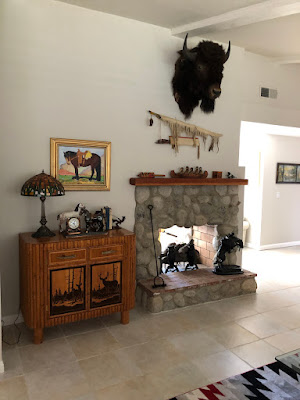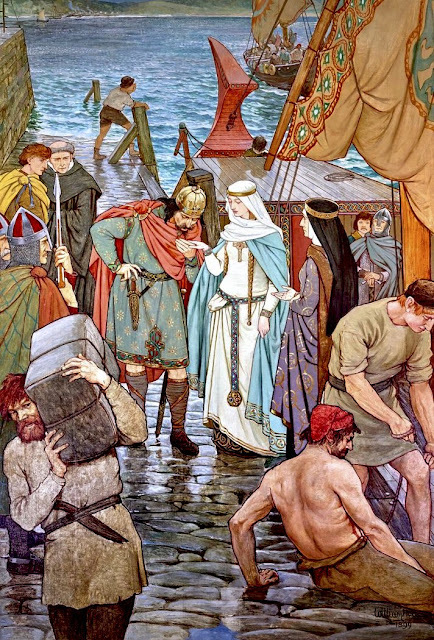SEE: http://laprairie-voyageur-canoes.blogspot.com/2017/10/ripples-from-la-prairie-voyageur-canoes.html
THEN IN THE FALL OF 2020, ANCESTRY (DOT COM) REVISED MY ETHNICITY ESTIMATE SO THAT SCOTLAND BECAME A SEPARATE REGION AND NOW ACCOUNTS FOR 47+% OF MY DNA MAKEUP.
Armed with that new information I decided to take a deeper dive into my family tree.
I concentrated on the following Scottish Surnames already in my tree:
Abernethy (m), Austine (d) (sept) [Branch of Keith], Baillie (m), Barlow (m), Bell (d), Boyd (m), Brodie (m), Brolachan or O'Brolachan from Kintyre (also Bradley) (d), Broun [Brown] (d) (m), Bruce (m), Cameron (d), Campbell (m) (d), Colquhoun (m), Cunningham [Conyngham] (m), Denniston (m), Douglas (m), Drummond (m), Dunbar (m), Elphinstone (m), Erskine (m), Fleming (m), Forbes (m), Fraser (m), Galbraith [Galbreath] (d), Graham (m), Grant (m), Guthrie (m), Hay (m), Hamilton (m), Hepburn (m), Innes (m), Johnstone (d), Lamont (assoc. Munn) (d), Livingstone (d), Lockhart [Lockart] (d), Lyle (m), MacDonald (McDonald) (m), MacDonald of Sleat (d), MacEachern (d), MacIntyre (d), McIsaac (d), MacKenzie (m), MacLean (d) [aka McClean] (d), Maclachlan (d), MacLeod (d), MacLean (m), (McCleod) (m), MacMichael [became Mitchell] (d), MacMillan (d), MacNeill of Colonsay (d), Maxwell (m), Mowat (m), Munn (assoc. Clan Lamont) (d), Munro (m), Murray (d), Ogilvie (m), Raitt (m), Paterson (m), Ramsay (m), Robert (m), Robertson (m), Shaw (m), Sinclair (m), Somerville (m), Stewart (m), Sutherland (m), Urquhart (m), Wallace (m) and Wilkie (d) (sept) [Branch of MacDonald] * Mom’s lineage = (m) & * Dad’s lineage = (d)

MY 2020, ETHNICITY ESTIMATE (SCOTLAND 47%)
Primarily located in: Scotland, Northern Ireland & Brittany France. My ethnicity estimate is 47%, but it can range from 42—61%.
With its center in the northern third of the island of Great Britain but stretching down to Brittany in France, our Scotland ethnicity region is known for its geographical beauty, medieval architecture, and folklore. Gaelic and Scots have influenced regional English dialects and are both still spoken in some areas. National symbols, including the Lion Rampant, clan tartans, and bagpipes, are often recognized internationally alongside symbols of traditional cuisine, like whiskey and haggis.
Back in 2011, I ordered both maternal lineage (MtDNA) and paternal lineage (Y-46) DNA tests from ancestry (dot com).
The results of those early tests suggested mom's ancient ancestors may have migrated to Europe settling in present-day Basque Country and other parts of Europe, and dad's ancient ancestors probably lived in present day Scandinavia.
MY 2013, ETHNICITY ESTIMATE 100% EUROPEAN
This estimate suggested my ethnicity is 100% European broken down as follows: 53% Western European, 21% Irish, 20% English and Scotch with trace amounts 4% from the Iberian Peninsula and 2% from Scandinavia.

I FOUND A THOUSAND YEARS OF ROYAL SCOTS ANCESTRY:
• Fergus Mór mac Eirc 1st king of Dál Riata 430-501
46th great-grandfather
• Kenneth I MacAlpin King of the Picts 810-858
34th great-grandfather
• Constantine I (Constantín mac Cináeda) King of the Picts 862-877
33rd great-grandfather
• Donald II King of Scots (Alba) 889-900
32nd great-grandfather
• Malcolm I King of Scots (Alba) 943-954
31st great-grandfather
• Kenneth II (Coinneach mac Mhaoil Chaluim) King of Scots (Alba) 971-995
30th great-grandfather
• Malcolm II King of the Scots 954-1034
29th great-grandfather
• Duncan I King Of Scotland 1001-1040
27th great-grandfather
+
• Suthen (Aelflaed, Sybilla, Sibyl) Fitzsiward Queen Of Scotland 1014-1040
27th great-grandmother
+
• Macbeth King of Scotland 1014-1057
husband of 27th great-grandmother
Fergus de Galloway King, 1st Lord of Galloway 1096-1161
27th great-grandfather
• King Malcolm III Longneck of Scotland Caennmor 1031-1093
26th great-grandfather
+
• Saint Margaret Atheling of Wessex Queen of Scotland 1045-1093
26th great-grandmother
• Matilda Dunkeld Good Queen Maud of Scotland 1080-1118
26th great-grandmother
• David I King of Scotland 1084-1153
25th great-grandfather
• Edgar King of Scotland 1074-1107
25th great-granduncle
• Alexander I King of Scotland 1078-1124
25th great-granduncle
Alan fitzRoland Lord of Galloway, Constable of Scotland 1175-1234
24th great-grandfather
• Sir William Wallace of Elderslie 1272-1305
21st great-grandfather
• Robert I "The Bruce" King of Scotland 1274-1329
20th great-grandfather
• Sir James 'the Good' & 'Black Douglas' Douglas (supporter of Robert the Bruce) 1286-1330
19th great-grandfather
• Robert II Stewart King of Scotland 1316-1390
18th great-grandfather
• Robert III King of Scotland 1337-1406
17th great-granduncle
• Henry I Sinclair (St. Clair) Earl of Orkney, Lord of Roslin 1345-1400
17th great-grandfather
• James Stewart Black Knight of Lorne 1383-1451
16th great-grandfather
+
• Joan Beaufort Queen of Scots 1406-1445
16th great-grandmother
• James II Stewart King of Scotland 1430-1460
16th great-grandfather
• James III Stewart King of Scotland 1451-1488
15th great-grandfather
+
• Margaret of Denmark, Queen of Scotland 1456-1486
15th great-grandmother
• James IV Stewart King of Scotland 1473-1513
14th great-grandfather
• James V Stewart King of Scotland 1512-1542
13th great-granduncle
• James Hepburn Duke of Orkney, Earl of Bothwell 1536-1578
12th great-granduncle
+
• Mary Stuart Queen of Scots 1542-1587
wife of 12th great-granduncle
• Sir Robert Boyd 1st Lord of Kilmarnock 1420-1482
17th great-grandfather
Agreement signed by Mary Queen of Scots, confirming arrangements made
with Queen Elizabeth for her, by (5th) Lord Boyd and others – 9 February 1569

• SOMERLED MAC GILLEBRIDE KING OF THE ISLES
23rd great-grandfather (dad's side of family tree)
25th great-grandfather (mom's side of family tree)
We are descended from two 1/2 Brothers, Sons of Lord John MacDonald of Islay, Lord of the Isles who was Somerled's 3rd great-grandson.
Our earliest lineage looks like this:
• SOMERLED MAC GILLEBRIDE KING OF THE ISLES 1100-1164 -- 23RD GREAT-GRANDFATHER
• KING RAGNALL (RANALD) MAC SOMHAIRLE (MACSORLEY) OF THE ISLES 1141-1207 -- Son of Somerled Mac Gillebride King of the Isles
• DONALD "EPONYMOUS" MACRANALD OF THE ISLES 1190-1269 -- Son of King Ragnall (Ranald) mac Somhairle (MacSorley) of the Isles
• LORD ANGUS MOR MACDONALD OF ISLAY 1249-1293 -- Son of Donald "Eponymous" MacRanald of the Isles
• LORD ANGUS OG MACDONALD OF THE ISLES 1272-1324 -- Son of Lord Angus Mor MacDonald of Islay
• LORD JOHN MACDONALD OF ISLAY, LORD OF THE ISLES 1326-1386 -- Son of Lord Angus Og MacDonald of the Isles
.
Our tree branches out here with two 1/2 Brothers, Sons of Lord John MacDonald of Islay, Lord of the Isles:
[DAD'S LINE BEGINS]
LORD DONALD MACDONALD OF HARLAW, LORD OF THE ISLES –1423 -- 17th great-grandfather
AND
[MOM'S LINE BEGINS]
RANALD MACDONALD 1ST OF CLANRANALD & GLENGARRY 1352–1386 -- 19th great-grandfather
EARLIER 2014 SCOTLAND DNA NOTES FROM MY BLOG:
Saturday, September 6, 2014
DNA Links Grandma To Scotland
https://a-drifting-cowboy.blogspot.com/2014/09/dna-links-grandma-to-scotland.html
Sunday, March 9, 2014
Was Great Granddad A Viking King?
https://a-drifting-cowboy.blogspot.com/2014/03/was-great-granddad-viking-king.html
Update Sep. 2021
My latest ethnicity update reveals my Viking ancestry, so where it was previously Scotland 47+%, it now reflects Scotland at 40% and Sweden, Denmark, Norway and the Baltics at 9%. Fascinating!















.jpeg)
.jpg)





















